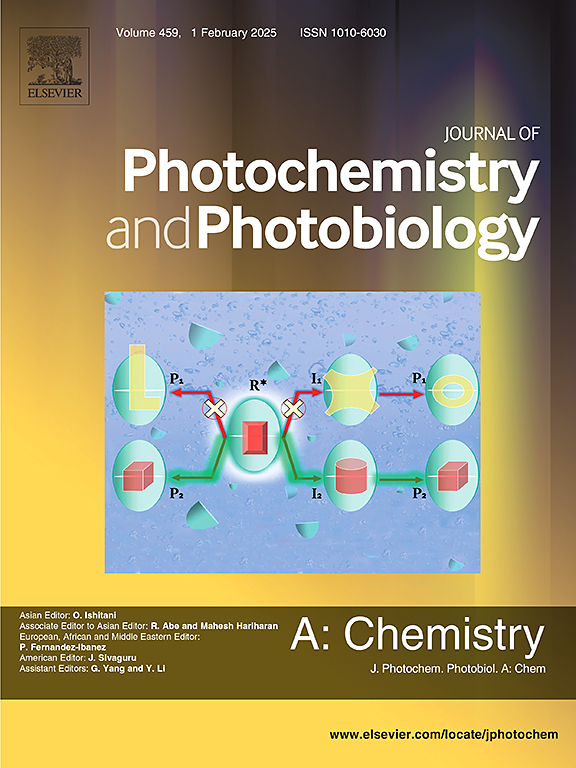On a nanocontainer having a magnetic core and a porous shell loaded with Erythrosin B for the optical sensing and adsorption of perfluorooctane sulfonate
IF 4.1
3区 化学
Q2 CHEMISTRY, PHYSICAL
Journal of Photochemistry and Photobiology A-chemistry
Pub Date : 2025-07-01
DOI:10.1016/j.jphotochem.2025.116604
引用次数: 0
Abstract
The pollution of per- and poly-fluoroalkyl substances (PFAS) has attracted increasing research attention due to their wide applications in daily life, which consequently demands reliable detection and treatment techniques for PFAS pollutants. In this work, we intend to construct an optical sensing and removal platform (denoted as EB@Fe3O4) for perfluorooctane sulfonate (PFOS), using Erythrosin B (EB) as the probe and a core-shell structure of Fe3O4-silica as the carrier. The optical sensing performance of EB towards PFOS was first discussed through its photophysical responses to PFOS, including absorption spectra, emission spectra, and emission quantum yields. An emission turn-on effect was observed from EB after adding PFOS with the help of hexadecyltrimethylammonium bromide (CTAB) due to the interaction between EB:CTAB micelles and PFOS. An optimal concentration ratio of EB:CTAB was determined as 0.5 μM:80 μM. Then, this core-shell structure was characterized and confirmed by SEM (scanning electron microscopy), XRD (X-ray diffraction), N2 adsorption/desorption, and TGA (thermal gravimetric analysis). The guest molecules of EB:CTAB were loaded into the porous tunnels of EB@Fe3O4 with a weight ratio of 34 %. EB@Fe3O4 showed a linear emission turn-on effect within the PFOS concentration region of 0 to 14 μM, with a LOD of 0.29 μM and good sensing selectivity (except for perfluorooctanoic acid). EB@Fe3O4 could remove PFOS effectively, with an adsorption capacity of 0.115 mg/g.

用于全氟辛烷磺酸的光学传感和吸附的具有磁性核和装载红素B的多孔壳的纳米容器
单氟烷基和多氟烷基物质因其在日常生活中的广泛应用而引起越来越多的研究关注,因此需要可靠的PFAS污染物检测和处理技术。本研究拟以红素B (EB)为探针,以fe3o4 -二氧化硅核壳结构为载体,构建全氟辛烷磺酸(PFOS)的光学传感去除平台(EB@Fe3O4)。首先讨论了EB对全氟辛烷磺酸的光物理响应,包括吸收光谱、发射光谱和发射量子产率。在十六烷基三甲基溴化铵(CTAB)的帮助下,由于EB:CTAB胶束与全氟辛烷磺酸的相互作用,在EB中发现了全氟辛烷磺酸的发射开启效应。EB:CTAB的最佳浓度比为0.5 μM:80 μM。然后,通过SEM(扫描电镜)、XRD (x射线衍射)、N2吸附/解吸和TGA(热重分析)对该核壳结构进行了表征和证实。将EB:CTAB的客体分子以34%的质量比加载到EB@Fe3O4的多孔通道中。EB@Fe3O4在PFOS浓度0 ~ 14 μM范围内呈线性发射导通效应,LOD为0.29 μM,具有良好的传感选择性(全氟辛酸除外)。EB@Fe3O4能有效去除全氟辛烷磺酸,吸附量为0.115 mg/g。
本文章由计算机程序翻译,如有差异,请以英文原文为准。
求助全文
约1分钟内获得全文
求助全文
来源期刊
CiteScore
7.90
自引率
7.00%
发文量
580
审稿时长
48 days
期刊介绍:
JPPA publishes the results of fundamental studies on all aspects of chemical phenomena induced by interactions between light and molecules/matter of all kinds.
All systems capable of being described at the molecular or integrated multimolecular level are appropriate for the journal. This includes all molecular chemical species as well as biomolecular, supramolecular, polymer and other macromolecular systems, as well as solid state photochemistry. In addition, the journal publishes studies of semiconductor and other photoactive organic and inorganic materials, photocatalysis (organic, inorganic, supramolecular and superconductor).
The scope includes condensed and gas phase photochemistry, as well as synchrotron radiation chemistry. A broad range of processes and techniques in photochemistry are covered such as light induced energy, electron and proton transfer; nonlinear photochemical behavior; mechanistic investigation of photochemical reactions and identification of the products of photochemical reactions; quantum yield determinations and measurements of rate constants for primary and secondary photochemical processes; steady-state and time-resolved emission, ultrafast spectroscopic methods, single molecule spectroscopy, time resolved X-ray diffraction, luminescence microscopy, and scattering spectroscopy applied to photochemistry. Papers in emerging and applied areas such as luminescent sensors, electroluminescence, solar energy conversion, atmospheric photochemistry, environmental remediation, and related photocatalytic chemistry are also welcome.

 求助内容:
求助内容: 应助结果提醒方式:
应助结果提醒方式:


